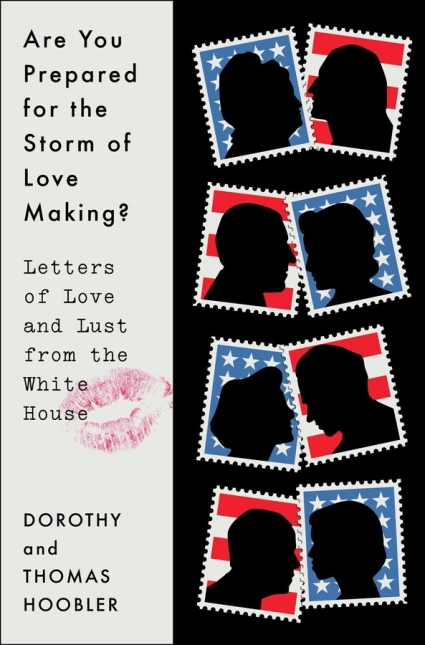Are You Prepared for the Storm of Love Making?: Letters of Love and Lust from the White House
- By Dorothy and Thomas Hoobler
- Simon & Schuster
- 304 pp.
- Reviewed by Paula Tarnapol Whitacre
- February 8, 2024
This mostly staid compilation is far from sexy.

With Valentine’s Day around the corner, you could send your sweetie a card — or you could dip into the romantic musings of a U.S. president or two for amorous inspiration. Based on the correspondence collected in Dorothy and Thomas Hoobler’s Are You Prepared for the Storm of Love Making?, I suggest stopping at the nearest Hallmark Store.
The book is a compilation of letters, in whole or excerpted, organized into four themes: Romancing, Separation, Adversity, and Lovers. The Hooblers begin each section with an overview of the letters they’re presenting, and every letter has a lead-in to place it in context. If I counted correctly, 40 of 45 presidents are included at least once. For a few of them (I’m looking at you, Woodrow Wilson), my reaction quickly became, “Thanks, I’ve seen enough.” In most cases, the Hooblers’ backstories are more intriguing than the letters themselves.
Despite the book’s provocative title (lifted from one of Wilson’s messages to his first wife, Ellen), a storm of lovemaking it is not. This may not be a bad thing. The Hooblers contend that the letters show our leaders as “playful, passionate, tender, consumed by desire.” I’m not sure I want to know the desires of Warren G. Harding as he anticipated his next encounter with his mistress or to read James Garfield’s or Franklin Roosevelt’s personal notes to the wives they cheated on.
Some of the letters are more business-like than emotional; some are sappy; some are just boring. Others demonstrate that many of the men’s courting skills involved about as much sensuality as a federal regulation. To wit: In 1797, John Quincy Adams warned his betrothed, Louisa Johnson, against “any attempt by those whom I love to cross the current of my character, or control my sentiments or manners.”
Reader, she married him anyway.
Some of our commanders-in-chief professed deep bonds of affection to loved ones while taking actions or supporting policies that denied others that same opportunity. Most early presidents were enslavers; many who came after the Civil War were racist, anti-labor, or otherwise governed more with hate than love. The Hooblers recognize this paradox but “stress that in this book, we write about the presidents as men who fell in love and expressed their feelings as other men did.” Some readers will be fine with this “lens” (the authors’ word), but I cannot compartmentalize so easily.
Part of the Hooblers’ challenge in assembling their book was to locate letters in the public domain. Thomas Jefferson’s wife, Martha, stated that hers should be burned at her death. The family of Gerald and Betty Ford has made public only one letter between the couple. Many letters are already well known, such as the prolific correspondence between John and Abigail Adams. But several, say the authors, have “never been previously published.” It would’ve been interesting to learn how they remained private until 2024. Did the Hooblers come upon formerly unnoticed files? Were they granted permission denied to others?
Recent presidents are barely represented here. No Reagans, no Clintons, no George and Laura Bush, no Bidens. The Obamas make an appearance via an excerpt from Michelle Obama’s memoir, a birthday note, and a tweet. As for Donald and Melania Trump? Let’s not even go there.
Unfortunately, the book’s typography hampers its readability. To differentiate between the Hooblers’ words and the presidents’, the latter are italicized. The result is long, run-on paragraphs of italics, which I found tough on the eyes. Also, because a president’s letters may appear in one or more of the four sections, a table or other listing of where each man’s words can be found would’ve been helpful.
The Hooblers have written more than 100 books, both fiction and non. (A neat fact from their website: After Thomas won $500,000 on “Who Wants to Be a Millionaire?” in 2001, with Dorothy as one of his lifelines, they used the money to pivot writing genres from YA to adult.) I appreciate their attempt to humanize our heads of state and to elevate the art of letter-writing, even if I found my attention drifting from the actual letters.
If you’re the type who visits the first ladies’ inauguration gowns at the Smithsonian, this work will round out your picture of behind-the-scenes White House lives. But A Storm of Love Making? More like A Compilation of Correspondence. That title may not sell as many books, but it’s a more accurate representation of what’s between the covers.
Paula Tarnapol Whitacre writes about history, with a focus on 19th-century social history. She is currently working on a book about the Civil War and Reconstruction as experienced in Alexandria, Virginia.

